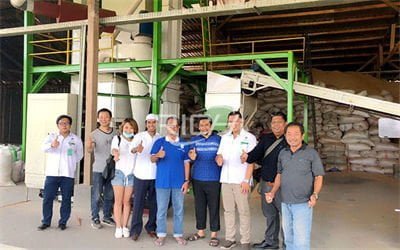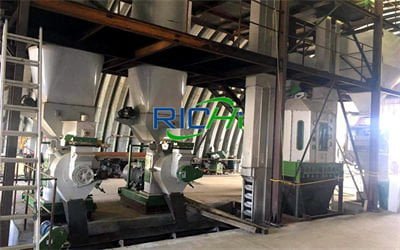
Fuel Pellet Plant
The best fuel pellet plant technology is to compress various biomass raw materials (mainly crop straw, agricultural product processing waste, forest wood processing waste, etc.) through pulverization, drying, high-pressure molding and other links to compress the original raw materials without a certain shape.
It is one of the most common and effective technologies to utilize biomass energy at home and abroad.


Advantages Of Fuel Pellet Plant

Fuel pellet manufacturing plant can solve crude fiber granulation, such as: wood chips, peanut shells, palm residue, sugar beet residue, rice husks, cotton stalks, cottonseed husks, weeds and other crop straws and other fibrous wastes.
The technical scheme of fuel pellet production plant granulation is designed for raw materials that are light, low in adhesion and difficult to form. The investment cost of the biomass fuel pellet unit is low, or it can be made into a small mobile unit, which is convenient for production and reduces the transportation cost of crops.
The fuel pellet manufacturing plant customized by Richi Machinery for customers has a high degree of automation, easy operation, integrated modularization, compact equipment, scientific fuel pellet production process flow, smooth production, complete product spectrum and wide coverage.
Prooduction Process And Euqipment Of Fuel Pellet Plant

Richi Machinery is committed to providing users with high-quality fuel pellet processing plant equipment and providing comprehensive technical support. According to different waste properties such as straw and wood, the configuration and construction plan of fuel pellet production line are customized.
Since the actual fuel pellet making process of for different biomass materials is different, the following only lists the most complete fuel pellet production process.In addition to various agricultural and forestry wastes, if your raw materials are bentonite, waste tires, waste newspapers, cardboard, bean curd residue, etc., you are welcome to contact Richi Machinery at any time, and we will customize the most reasonable solution for you.

Standard Biofuel Pellet Plant Process:
01 Raw Materials Prepareation
Send needle or foam debris into buffer bin.
02 Moisture Regulation
The moisture is taken away by the dying machine or cyclone to achieve the moisture of granulation by fuel pellet mill.
03 Screening (Impurity Removal) Section
Screening with a screening machine to remove debris such as stones, iron blocks or larger wood blocks.
04 Material Conveying Section
Use screw conveyor, auger conveyor and elevator to convey material to fuel pellet mill.
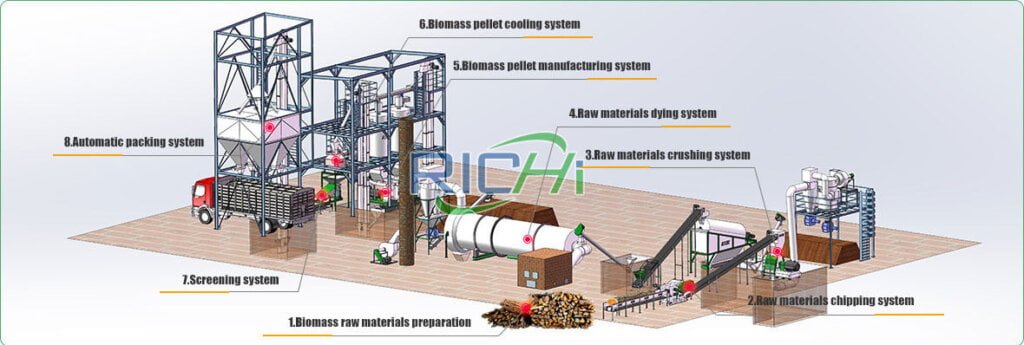
05 Pelletizing Section
The raw material is compressed into pellets using a fuel pellet making machine.
The powder is fed into the two pressing areas in the ring die by the feeding scraper. Due to the high-speed rotation of the fuel pellet machine ring die, the material is brought between the ring die and the pressing roller.
Under the strong pressing action of the ring die and the pressing roller, the The material is gradually compacted and formed in the fuel pellet machine die hole. Since the extrusion of the material between the die rollers is continuous, the formed material is continuously discharged from the die hole in a columnar shape, and then cut into the required appropriate length by the cutter pellet.)
06 Cooling Section
The temperature of the newly pressed fuel pellets is relatively high, the structure is relatively loose, and it is easy to break. It must be cooled to room temperature.
07 Screening Section
The vibrating screen is used for screening, and the debris is screened out to ensure the quality of the biomass pellet fuel.
08 Packaging Section
The finished biofuel pellets are sent to the finished product warehouse through the elevator, and are transported to customers in bulk or packaged according to pellet fuel manufacturers’ needs.
At the same time, we optimize the combination of various types of equipment to finally meet the customer’s demand for high output and low consumption of fuel pellets processing.
We Can Supply Fuel Pellet Plant With:
- Output: 0.3-60T/H
- Fuel pellets size: 6-12mm
- Applicable raw materials: all agricultural and forestry wastes
Equipment Needed For Fuel Pellet Plant
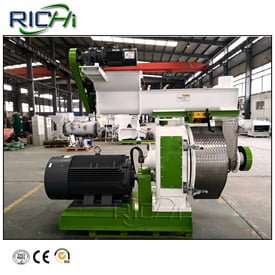
Fuel Pellet Mill Machine
MZLH series ring die type fuel pellet granulator machine is suitable for pellet production of all agricultural and forestry wastes, municipal waste.

Rotary Screener
Used to screen out qualified fuel granules, then go into packing section. The equipment can also be used in raw material cleaning section.

Bagging Machine
According to different finished product requirements, the packaging bag can be dozens of kilograms or hundreds of kilograms.

Grass Crusher
It is used for crushing all kinds of pasture, hay and straw, and can be directly granulated after crushing. For biopellet plants & feed mill plants.

Wood Chipper Machine
Used to crushing raw materials such as small tree trunks, wood logs and wood strips into wood chips.
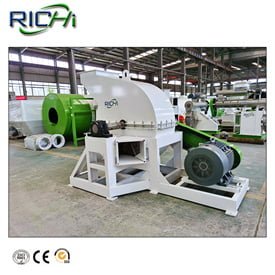
Wood Crusher
This is an all-in-one slicing and crushing machine, which is more suitable for small-volume fuel wood pellet plants.
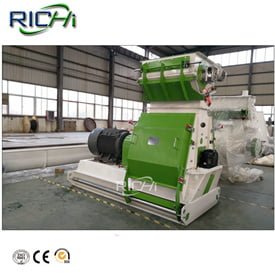
Biomass Hammer Mill
It is used for crushing all kinds of pasture, hay and straw, and can be directly granulated after crushing.

Wood Chip Dryer
Used to dry biomass raw materials. The setting of drying section is different in different production process.
No matter what kind of wood pellet production line process you want, we can customize equipment and solutions according to your raw material and finished product requirements. Feel free to contact us for technical support!
RICHI MACHINERY
Fuel Pellet Plant Cases
No matter what kind of fuel pellets you want to produce, RICHI can provide you suitable fuel biomass pellet production line solutions.

5T/H Fuel Pelelt Plant In Austria
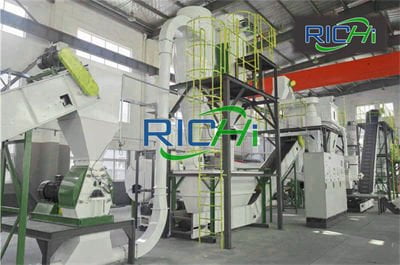
Germany 2-2.5 T/H Fuel Pellets Plant

Romania 2-2.5TPH Fuel bio Pellet Plant

Poland 2-3T/H Fuel biomass Pellet Plant
What Can Richi Machinery Offer For Your Fuel Pellet Plant?
01
Overall Fuel Pellet Production Project Planning
Covers: planning of fuel pellet equipment, project personnel configuration plan, office facilities, water, electricity, dust removal, noise reduction and sewage equipment, etc.
02
Procurement Of Biofuel Machines Required
Covers: main bio fuel machine, belt transportation system, central control system, sewage treatment system, dust removal and noise reduction system, etc. (Related product: biomass pellet mill for sale)
03
Construction Of The Fuel Pellets Plant Project
Covers: area construction, biomass fuel pellet machine infrastructure, dust removal and noise reduction sewage system construction, biofuel pellet machine installation and testing, technical personnel training, etc.
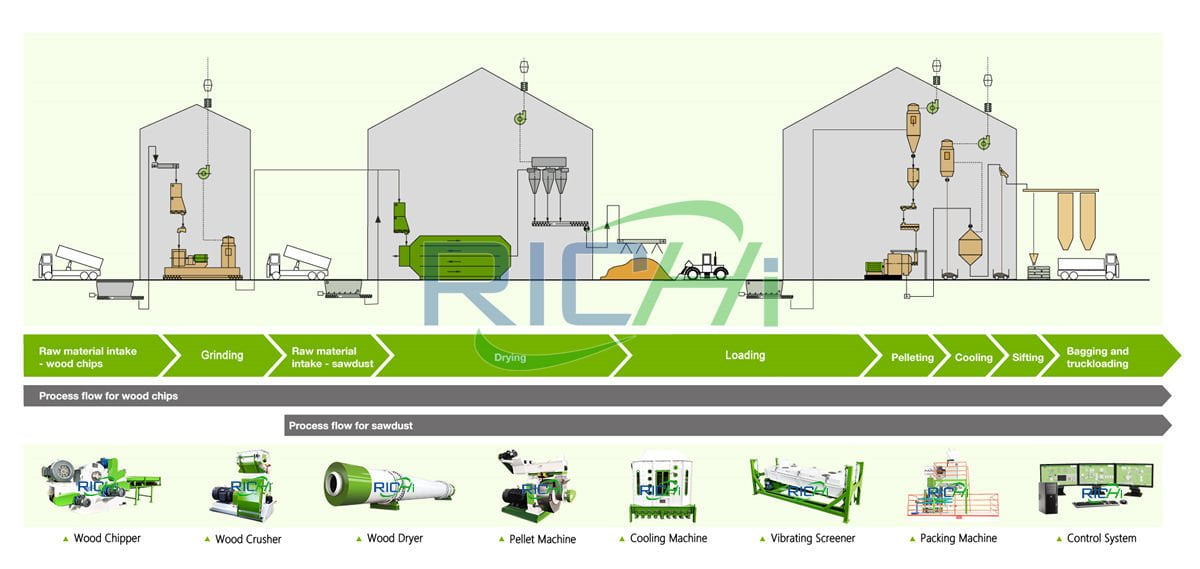
Understanding the needs of each customer is awe of biofuel pellet manufacturers. In the field of fuel pellet processing, Richi Machinery is committed to creating world-class pellet plant solutions. Our ultimate goal is to reduce the cost of use of customer equipment, improve the efficiency of equipment use, and help customer industries take root and deepen their cultivation.
How To Set Up Complete Fuel Pellet Plants?
For a long time, as a biofuel machine manufacturer, Richi Machinery has accumulated rich practical experience, tailor-made reasonable and practical fuel pellet processing solutions for thousands of customers, and provided a full set of services throughout the pre-sale, in-sale and after-sale services.
The following is a brief demonstration of several fuel pellet process solutions, all of which are customized according to the needs of different pellet fuel manufacturers. Nothing tells you how to build a fuel pelleting plant more clearly than a specific solution. Here are some examples of custom solutions for common production capacity. If you want to start your own bioenergy pellet plant, contact Richi Machinery!
1.5T/H Biomass Fuel Pellet Plant Solution
- Investment of fuel pelletizing plant: 150,000 USD (The pellet plant cost includes a full set of fuel pellet machine and plant leasing/renovation/construction)
- Scale: 1.5t/h, 2500t/a (calculated according to the working hours of the customer pellet plant)
- Total area of the project: 3700m2
- Construction content: The client uses its own idle workshops to build, mainly to build production workshops, offices, and warehouses.
- Production workshop height: 6m (steel structure)
- Project raw materials and consumption: straw (3125t/a)
- Power consumption: 370000kwh/a
- The main bio fuel machines: fuel pellet mill, biomass hammer mill, cooler, conveyor, bag filter, forklift, etc.
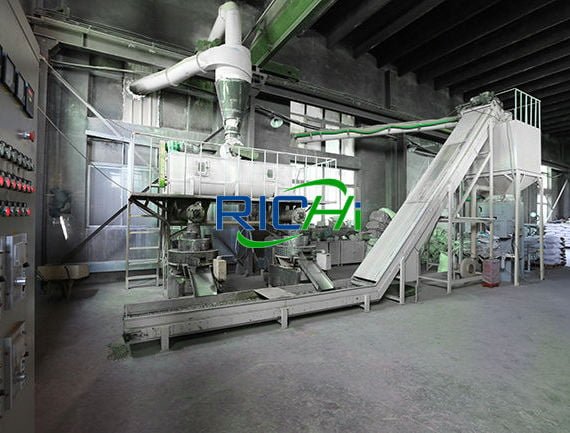
Customized Fuel Pellet Plant Process Design:
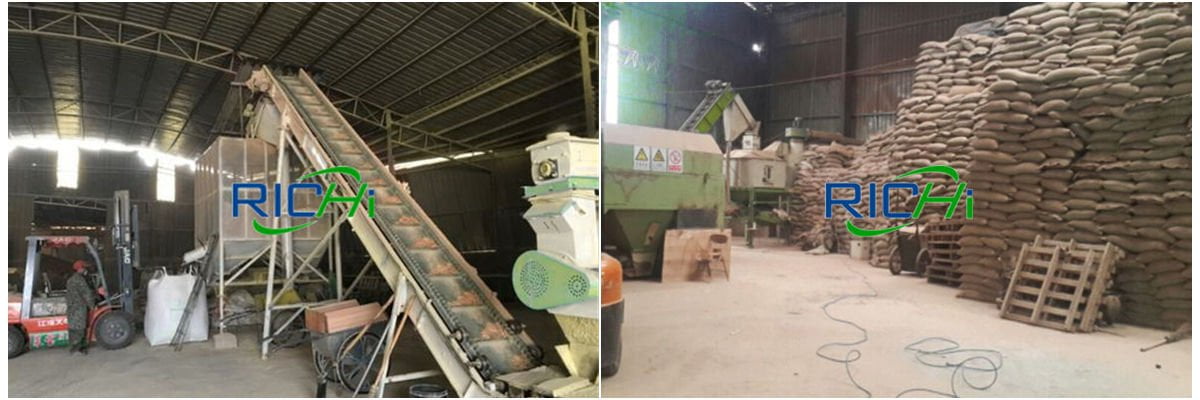
- Transportation and unpacking: After the collected raw materials are transported into the factory, they are unpacked and stored in the material yard. After the moisture content is naturally dried to less than 10%, they are transported to the production workshop for crushing.
- Pulverization: The raw materials are pulverized in the production workshop, and the pulverized raw materials are less than 5mm.
- Pelleting and forming: After crushing, it is transported to the fuel pellet mill. The principle of granulation is the collision and extrusion between the material and the machine and between the materials. Through the action of mechanical pressure, the crushed material is extruded into a regular, dense Larger molding materials.
- Cooling: The temperature of biomass particles at the discharge port of the fuel pellet making machine is 80-90℃, and the biomass particles are sent to the cooler for cooling through the conveyor.
- Packaging and storage: The pellet heater fuel of the customer fuel pellet plant project are cooled and packed manually and stored in bulk. The products are transported to the warehouse for storage, and the products are sold immediately after production, and no large-scale storage is required.

8T/H Biomass Pellet Plant Solution
- Investment: 750,000 USD (The fuel pellet line cost includes a full set of fuel pellet machine and plant leasing/renovation/construction)
- Scale: 8t/h, 20000t/a
- Total area of the project: 13052m2
- Construction content: The customer rents idle vacant land to build production workshops, raw material warehouses, finished product warehouses and supporting facilities.
- Production workshop: 1F, brick-concrete structure
- Project raw materials and consumption: straw (6000t/a), chaff (6000t/a), waste board (mainly wood) (8000t/a)
- Raw material requirements: moisture content ≤ 20, no impurities such as gravel, iron filings, sediment, plastic, etc., and the sulfur content of waste gas sheet ≤ 0.08.

- Pellet specifications: diameter 8-10mm, length 20-50mm, high calorific value 3450-4200kcal/kg, moisture content 12-18%, density >1.12kg/m3, ash <1.5%.
- The main biofuel machines of the fuel pellet plant project: template crusher, wood fuel pellet making machine, wood chip crusher, belt conveyor, bag filter, etc.
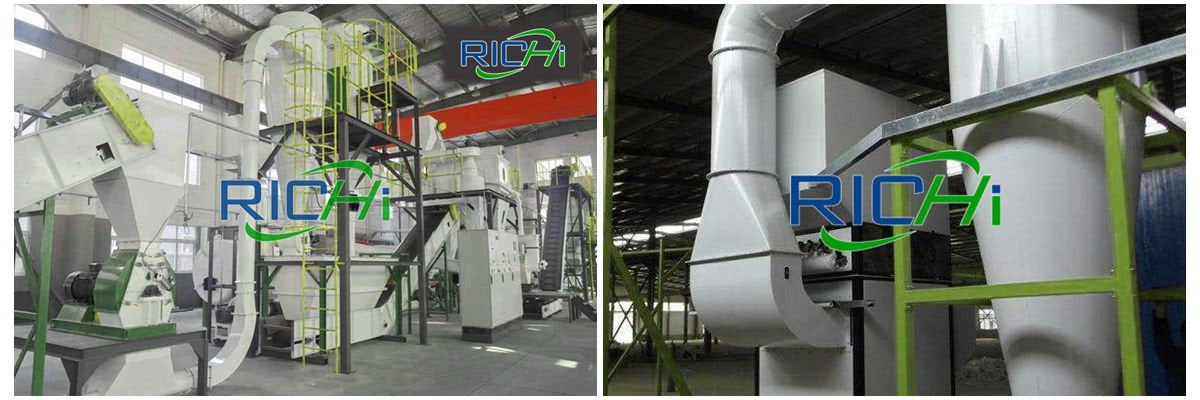
Customized Fuel Pellet Production Process Design:
- Material: Purchase dry straw, chaff, etc. as required. Raw material requirements: low moisture content, no impurities such as gravel, iron filings, sediment, plastic, etc.
- Chipping and crushing: The material is fed from the loader to the sealed conveying line, and transported to the crusher by the belt for crushing to obtain crushed materials with larger particle size. Iron and other impurities are removed, and the crushed material is fed by the loader to the belt and transported to the pulverizer for crushing to obtain crushed material with a particle size of less than 10mm.
- Pelletizing and molding: The fuel pellet mill is the key equipment of the biomass pellet manufacturing plant. After the crushed raw materials pass through the fuel pellet machine in a closed environment, the finished biomass fuel pellets with a diameter of 8mm and a length of 20-40mm are formed.
- Packing: The pressed products are packaged and transported to the finished product warehouse.

2T/H Biomass Fuel Pellet Plant Solution
- Investment: 450,000 USD (The project cost includes a full set of fuel pellet machine and plant leasing/renovation/construction)
- Scale: 2t/h, 15000t/a (calculated according to the working hours of the customer pellet plant)
- Total area of the project: 4000㎡
- Construction content: production workshop, including production area, crushing area, raw material area, finished product area and auxiliary facilities.
- Production workshop: brick-concrete steel structure (12m high)
- Project raw materials and consumption: straw (7525t/a), waste wood (7525t/a)
- Project power consumption: 1000000kwh/a
- The main bio fuel machine: chipper, pulverizer, biofuel pellet machine, conveyor, transformer, feeder, etc.

Customized Fuel Pellet Plant Process Design:
The raw materials are straw and waste wood, which are transported by closed box trucks or vehicles covered with tarpaulins. After entering the fuel pelleizing plant site, they directly enter the raw material area of the workshop, unload the raw materials to the raw material area, and the entire production workshop is sealed.

- Pulverization: Some raw materials of the biomass pellet making plant project need to be pulverized. Forklifts are used to transport the raw materials from the raw material area to the hopper of the wood pellet hammer mill, and the raw materials enter the biomass materials crusher through the conveyor belt for pulverization. Some old wood raw materials are large and need to be sawn, and then enter the wood crusher for pulverization. The conveyor belt is sealed, and the pulverization process is completely sealed.
- Conveying: The materials collected by the cyclone dust collector are transported to the raw material area through the closed conveyor belt for temporary storage; the raw materials are transported from the raw material area to the hopper of the conveyor belt by a forklift, and the raw materials are transported to the biomass pellet machine through the closed conveyor belt for molding operation.
- Pelletizing: The material is transported to the pellet fuel machine through a closed conveyor belt, and enters the cyclone dust collector through the induced draft fan at the end of the conveyor belt. The material recovered by the cyclone dust collector enters the biofuel pellet machine, and is made into a finished product by extrusion molding. Between 6mm-10mm. The extrusion process is a physical process, no adhesive is added, and no chemical reaction occurs. The extrusion process of the material will heat up, and the molding temperature is between 70 and 80℃.
- Cooling: The pelletized fuel is cooled naturally through a closed conveyor belt, so that the temperature can reach the conditions for packaging and storage, and then transported to the finished product area.
- Packaging, finished products, storage: The biofuel pellets after cooling is packaged in different specifications according to customer needs, that is, finished products, which are put into storage for sale.
18-20T/H Biomass Fuel Pellet plant Solution
- Investment: 2,400,000 USD (The cost includes a full set of fuel pellet machine and plant leasing/renovation/construction)
- Scale: 18-20t/h, 100000t/a (calculated according to the working hours of the customer pellet plant)
- Total area: 2994.50m2
- Construction content: lease land, build raw material area, crushing area, crushing area, granulation area.
- Production workshop: fully enclosed steel structure
- Project raw materials and consumption: secondary fuelwood (30000t/a), three leftovers (wood, shavings, sawdust and other scraps) (45000t/a), crop straw (40000t/a)
- Project power consumption: 2.6 million kwh/a
- The main biofuel machines: slicer, pulverizer, bio pellet machine, silo, air compressor, conveyor, forklift, etc.

Customized Fuel Pellet Plant Process Design:
- The raw materials come from qualified suppliers and are inspected and put into storage.
- The purchased raw materials are put into storage, and the wood is crushed according to the order quantity. The leftover materials (such as iron nails, plastics, paper scraps, etc.) are sold and disposed of. The fuel pellet machine starts pelleting; finally it enters the silo for cooling and bagging into the warehouse.

4-5T/H Biomass Fuel Pellet Plant Design
- Investment: 4,050,000 USD (The plant cost includes a full set of fuel pellet machine and plant leasing/renovation/construction)
- Scale: 4-5t/h, 20000t/a (calculated according to the working hours of the pellet fuel manufacturer)
- Total area: 3743.59m2
- Construction content: There are 2 buildings in the project site, with an area of about 668 square meters, a new factory building with a construction area of about 3743.59 square meters, guards and other 100 square meters.
- Production workshop: steel structure
- Project raw materials and consumption: straw (2476t/a), wood chips (6316t/a), bamboo chips (6316t/a), branches (9000t/a)
- Project power consumption: 1.6 million kwh/a
- The main pellet fuel machine of the project: slicer, pulverizer, fuel pellet machine, Cyclone, dryer, conveyor, cooler, packing scale, etc.

Customized Fuel Pellet Plant Process Design:
- Raw materials: The raw materials are mainly crop straws, wood chips, bamboo chips and construction waste, etc. Generally, wood chips and bamboo chips can be directly granulated to produce biomass pellets without drying. The raw materials are crushed and dried before granulation.
- Slicing and crushing: Slice raw materials with larger diameters such as straw, branch wood, construction waste (wood), etc., and then enter the next process by refining 3-8mm powder.
- Drying: The biomass briquette fuel has strict requirements on the moisture content of the raw materials. After the raw materials are pulverized, they are dried by a tumble dryer. The tumble dryer uses the heat and hot air of the biomass waste hot blast stove to dry the raw materials, the moisture content of general raw materials is about 15-45% (the moisture content of raw materials such as straw, branch wood, construction waste (wood) is about 30-45%, and needs to be dried; the moisture content of raw materials such as wood chips and bamboo chips is about 15%, no drying is required), the drying program of the project is mainly aimed at branches and waste wood with high moisture content. After drying the raw materials, the moisture content of the raw materials is generally about 15%.
- Pelletizing and molding: The biomass dust after drying passes through a vertical ring die biomass fuel pellet machine, and the raw material is compressed and grown into cylindrical pellets with a diameter of 8mm to 9cm and a diameter of 8mm to 10mm.
- Cooling: When the raw material is processed into pellets, the temperature of biomass fuel pellets can reach 50℃~60℃, and it will be cooled to normal temperature by the cooler.
- Packing: The biomass pellets after cooling are bagged and packaged by the packaging machine and put into storage, which is the product. (Maybe you are interested in: biomass wood pellet plant in Indonesia)

1.2T/H Biomass Fuel Pellet Plant Scheme
- Investment: 225,000 USD (The pellet plant cost includes a full set of fuel pellet machine and plant leasing/renovation/construction)
- Scale: 1.2t/h, 3000t/a
- Total area of the pellet fuel company project: 1300m2
- Construction content: workshop, office area, warehouse and supporting facilities, mainly engaged in the production and sales of biomass fuel.
- Production workshop: closed steel structure
- Project raw materials and consumption: bamboo powder (1500t/a), wood chips (1500t/a)
- Project power consumption: 200000kwh/a
- The main bio fuel machine of the project: pulverizer, trommel screen, biofuel pellet machine, dryer, conveyor, air compressor, etc.
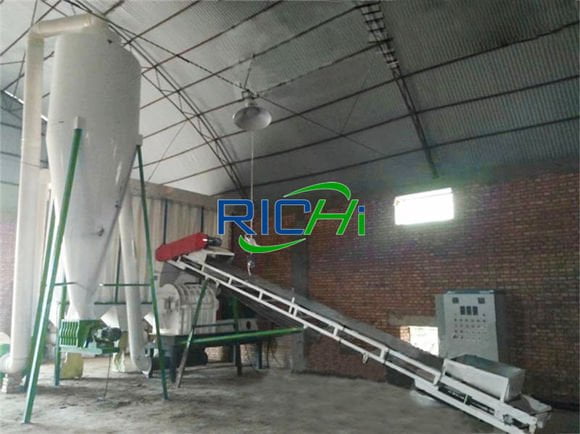
Customized Fuel Pellet making Process:
- Screening: The raw materials, bamboo powder and sawdust are screened by the drum screen, which are mainly used for the sorting of raw materials. The sieve hole of the rolling sieve is about 1cm, the bulk material enters the pulverizer, and the small material directly enters the wood pelletizer machine for granulation.
- Pulverization: The screened bamboo powder and wood chips are sent to the pulverizer by the belt conveyor, and the bamboo powder and wood chips are sent to the pulverizer by the forklift. Under the action of rotating centrifugal force, the material automatically flows out from the outlet and enters the material pit, which is covered and sealed.
- Use a fuel pellet dryer to dry the crushed raw materials.
- The pulverized material is sent to the extrusion bin of the particle processing machine by the screw conveyor, and the pulverized material is extruded into the inner hole of the mold through the pressing roller, and the extruded material is formed by the hot extrusion of the mold. The pellets are cut into cylindrical pellets at the outlet of the fuel pellet machine, and the whole process is physical extrusion molding without adding any binder.
- The temperature of the molded material can be brought to 60-80℃, and the product is cooled and cooled by the fan in the cooling bin.
- Packaging and warehousing: The finished solid fuel pellets products coming out of the discharge port are packaged and put into the warehouse.

2T/H Biomass Fuel Pellet Plant Scheme
- Investment: 83000 USD
- Scale: 2t/h, 5000t/a (calculated according to the working hours of the customer pellet plant)
- Total area of the project: 1200 ㎡
- Construction content: Use the existing workshop to purchase 2 biomass pellet machines and related equipment to build a new biomass pellet production line
- Production workshop: steel-concrete structure
- Project raw materials and consumption: walnut shell (3000t/a), sawdust and shavings (3000t/a)
- Product specifications: density 1~1.3t/m³, total moisture ≤10%, calorific value ≥4000KCal

- Project power consumption: 50000kwh/a
- The main bio fuel machine of the pellet fuel company project: pulverizer, fuel pellet mill, screw conveyor, finished product conveyor belt, cooling fan, bag filter, fan, packaging machine, transport vehicle, etc.
Customized Biofuel Pellet Plant Process Design:
- Removal of impurities: The impurities in the raw materials are manually selected and removed, and the impurities are mainly beverage bottles, cigarette shells, masks, cigarette butts, iron nails, etc.;
- Crushing: The raw materials other than sawdust, including walnut shells, shavings, etc., are crushed into biomass fine materials with a particle size of less than 1mm by a pulverizer; (Note: The raw materials used in this project are sun-dried walnut shells and dried sawdust shavings, so no drying is required).
- Pelletizing and molding: The powdery raw materials are transported to the granulating and molding machine through the closed feeding auger. This project adopts the normal temperature molding process without adding binder. The principle is to compress it into a compact shape under high pressure extrusion. Particles, that is, biomass raw materials contain cellulose, hemicellulose, lignin, etc., due to their relatively loose structure and low density, when subjected to external forces, the raw materials will undergo rearrangement, mechanical deformation, elastic deformation, and plastic deformation stages. The intertwining and twisting of inelastic or viscoelastic cellulose molecules to reduce the volume and increase the density is a physical process;
- Cooling: Under the friction of extrusion at room temperature, the temperature of the extruded particles is 55–65 ℃, which is easy to break and must pass through a counter-flow cooling system. In this project, a fan is set on the finished product conveyor belt to cool the material surface through counter-flow cold air. Cool down, and after cooling to room temperature, it can be transported to the packaging machine for bagging and storage, and the cooling method is air cooling;
- Package storage and outsourcing: The cooled solid fuel pellets are sent to the packaging machine for packaging by the finished product conveyor belt, and then transported to the finished product storage or outsourcing.



Start Fuel Pellet Plant, Start Your Profitable Future
As fuel for boilers and gas generators, or for heating industrial, domestic and agricultural garden conservatories, for countries with abundant biomass resources but poor oil and coal, biomass solidified pellet fuel will become a highly competitive alternative energy with considerable development prospects.
Richi Machinery always adheres to customer-centricity, provides one-stop fuel pellet factory services, and tailors high-quality fuel pellet production line processing solutions and processing equipment for customers.
Whether it is pre-sale, in-sale or after-sale links, we always actively listen to customer needs, combine the actual feedback from tens of thousands of users at home and abroad, constantly improve and upgrade, develop high-precision products with sincerity and meticulousness, and sincerely provide customers with professional fuel pellet manufacturing plants services.
Video Of Biomass Fuel Pellet Plant Site
Take root in the market and serve the world. Richi Machinery is committed to providing users with high-quality biomass fuel pellet equipment and providing multi-faceted technical support. According to the different properties of the biomass materials, the configuration and construction plan of the fuel pellet production line can be customized.
At the same time, we optimize the combination of various types of fuel pelleting plant equipment to finally meet the customer’s demand for high yield and low consumption of biomass fuel pellet production.
The Growing Biomass Pellet Fuel Industry
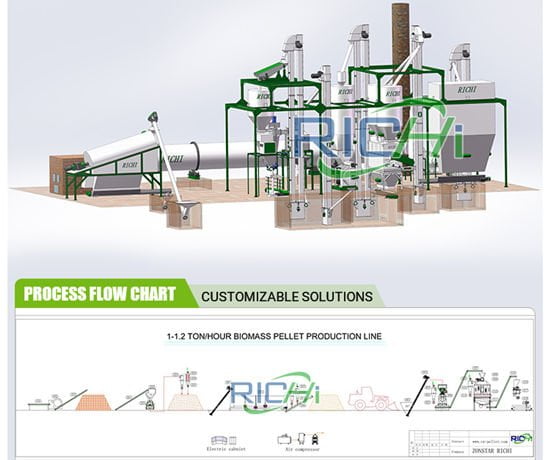
At the end of the 20th century, biomass was put forward as a special concept, and began to be systematically developed for industrialization, but the proposed perspective, concept and connotation are not consistent. It is generally believed that biomass mainly refers to renewable or recycled organic matter, including crops, trees and other plants and their residues; there are also considerations of efficient utilization of resources and circular economic benefits, and it is proposed that biomass is non-food lignocellulose. substance.
There are many types of biomass resources, mainly including agricultural waste and agricultural and forestry product processing industry waste, fuelwood, human and animal manure, and urban domestic waste. Biomass energy is the energy stored in biomass, which is stored in biomass by green plants converting solar energy into chemical energy through chlorophyll. Energy shortage and environmental crisis are two major problems restricting the economic and social development of the world today. Biomass energy has gradually become an important new energy because of its renewable, rich resources and friendly to the ecological environment. (Maybe you are interested in 3-3.5t/h straw pelleting plant solution)
In recent years, the social and economic development of human beings has become increasingly rapid, but this is at the cost of consuming a large amount of fossil energy and polluting the environment. Fossil energy is decreasing day by day, and environmental pollution is becoming more and more serious. It is urgent to find a renewable alternative energy.
Biomass energy is a kind of renewable energy with dual attributes of renewability and environmental friendliness. In recent years, more and more attention has been paid to biomass energy, and its consumption has jumped to the fourth place after oil, coal and natural gas.So, you can start focusing on starting a fuel pellet plant business.

Supplementary Information Of Fuel Pellet Production
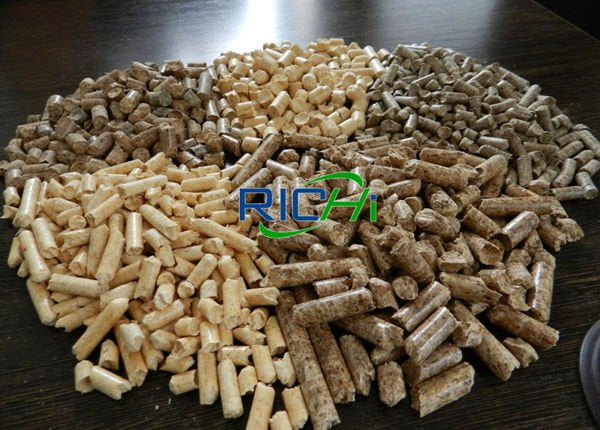
What’s Fuel Pellets?
Biomass pellet fuel is a solid renewable fuel with a diameter of ≤25mm, an aspect ratio of ≤4, and common diameters of 6, 8, and 10mm. It can be processed by cold compact molding from crop wastes such as straw, rice husk, peanut husk, or various raw materials such as pine, fir, birch, and poplar. After the biomass pellet fuel is compressed and molded, its volume is greatly reduced, which makes it more convenient for transportation, storage and use. It is widely used in industrial and agricultural production, power generation, heating and heating, boiler burning, and unit households.
Compared with ordinary wood fuel, biomass pellet fuel has the advantages of high density, high strength, easy transportation and loading and unloading, uniform shape and properties, good combustion performance, high calorific value, strong adaptability, and convenient fuel operation and control.
Characteristics Of Biofuel Pellets
Under the action of a certain external pressure, the biomass raw materials such as wood and straw will reach a certain temperature due to the mutual friction between the materials and between the materials and the mold roll, and the bonding effect of the lignin will make the plant body denser.
Evenly, when the external pressure is removed, the original structure and shape cannot generally be restored due to the mutual entanglement between fiber molecules. After cooling, the strength increases and becomes a pellet fuel.
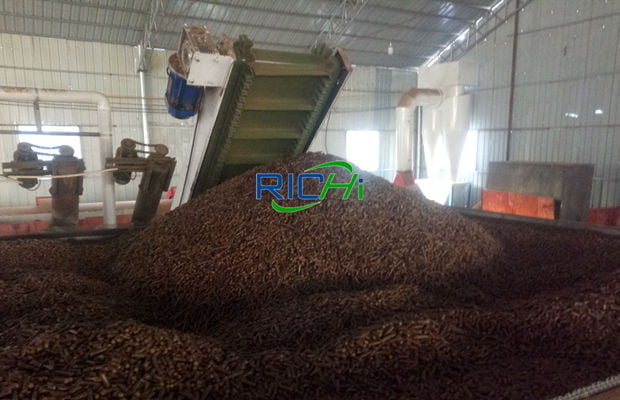

The higher the volatile content of the pellets for fuel, the easier it is to ignite and the better the combustion performance. The volatile content of biomass pellet fuel is as high as 60% to 70%, which is much higher than that of coal, so its ignition performance and combustion performance are better than coal.
The carbon content is 35% to 42%, which is much lower than that of coal, which makes its calorific value lower than that of coal; the N content is 0.5% to 3%, and the S content is only 0.1% to 0.5% t. The emission is much lower than that of coal, and the CO2 emitted and the CO2 absorbed by straw photosynthesis reach a balance, basically achieving zero emissions; compared with the original biomass resources, the burning time of pellet fuel is longer. It can be seen that biomass pellet fuel is a kind of “high-quality, clean and efficient” fuel. (Maybe you are interested in 4-5t/h straw pellet production line)
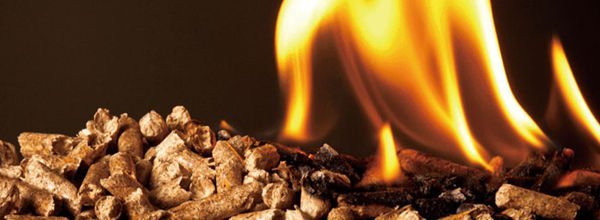
Physical And Chemical Properties Of Biofuel Pellet
The components of biofuel pellets are combustible matter, inorganic matter and water, and the specific indicators are as follows. Calorific value 20.24 MJ/kg, fixed carbon 15.58%, volatile matter 84.22%, carbon 49.72%, oxygen 35.81%, hydrogen 5.79%, sulfur 0.06%, nitrogen 0.16%, ash 1.26%, moisture 7.2%.
Quality Standards Of Biomass Pellet Fuel
In Europe, fuel pellets quality standards are established by the European Committee for Standardization (CEN).
01 Ash Content
If the scale of feed production is expanded, it is necessary to increase the number of poultry feed pellet making machine or poultry feed production lines, and thWood ash content varies according to soil type, tree age, site (needles, branches and bark) and harvest season. The minerals absorbed by the tree from the soil are mainly distributed to needles or leaves, small diameter branches and bark. The mass fraction of needle ash in conifers is about 5%, the bark part is about 3%, and the trunk is 0.5%.e total investment price will basically increase proportionally.
The ash content of pellet fuel is relatively high when the parts used in the fuel pellet plant granulation process are mainly bark and needles. The EU standard states that the ash content of the highest quality pellet fuel should be no more than 0.7% of the dry mass of the pellet fuel. The ash mass fraction of the black pine trunk was 0.23% to 0.28%, and the ash mass fraction of the whole European red pine tree was 1.1%.
02 Mechanical Durability
Mechanical durability is a very important quality parameter of pelletized fuel, because in the process of loading, unloading, transportation and storage, pellet fuel with low mechanical strength is easily broken, resulting in the increase of powder and affecting the feeding. At the same time, during the combustion process, also affects flue gas emissions.
A standard test for mechanical durability is by tumbling the pellet fuel and calculating the percentage of remaining pellet fuel after fines are removed. The Swedish Biomass Pellet Fuel Standard requires pellet fuels to have a mechanical durability greater than 95%.
Durability reflects the bonding performance of pellet fuel, which is determined by compression conditions and relaxation density. Durability, as an important characteristic of the quality of pellet fuel, is mainly reflected in different service performance and storage performance. The relaxed density of pellet fuel cannot comprehensively and directly reflect the differences in the use of briquette fuels.
Therefore, the durability is further refined into several indicators such as deformation resistance, crush resistance, rolling resistance, water permeability resistance and moisture absorption resistance.

03 Density
The volume of the raw material in the mold decreases with the increase of the pressure during the compression process. When the pressure increases to a certain extent, the volume does not change any more. The density of the material in the mold under the final pressure is called the compression density.
However, after the molded pellets or agglomerates are taken out of the fuel pellet machine ring die, due to elastic deformation and stress relaxation, the volume will gradually increase, and the density will continue to decrease, and tend to stabilize after a certain period of time. This density is smaller than the final compressed density in the mold, and is an important indicator for determining the physical properties and combustion properties of the fuel in the pellet fuel.
The relaxed density of biomass fuel pellets made by fuel pellet plant is closely related to the type of biomass and the compression molding process conditions. Due to different water content and different components of biomass, the relaxed density achieved under the same compression conditions will also be significantly different.
There Are Generally Two Ways To Improve The Relaxed Density Of Biomass Pellet Fuel:
- One is to use an appropriate compression time to control the stress relaxation and elastic deformation of the molding block when it is compressed in the mold, so as to prevent the decreasing trend of the compression density of the molding block after the fuel pellet machine mold is released;
- The second is to pulverize the biomass raw materials, reduce the particle size as much as possible, and appropriately increase the pressure and temperature of biomass compression molding or add binders to minimize the void ratio inside the molding block and enhance the bonding force.

The high density results in higher unit volume and energy, resulting in lower transportation and storage costs. The highest quality grade of pellet fuel made by biomass fuel pellet plant is specified in the EU standard with a density of not less than 600 kg/m3, but generally pellet fuel producers aim to produce pellet fuel with a density greater than 650 kg/m3.

